This post may contain affiliate links. Please read our disclosure policy.
Here is my recipe for aioli, the garlicky goodness that is a great dip for fries, a spread for sandwiches, or a topping for veggies and grilled foods. The best thing: You do not have to be in a restaurant to eat it. Make an authentic aioli at home in your food processor.
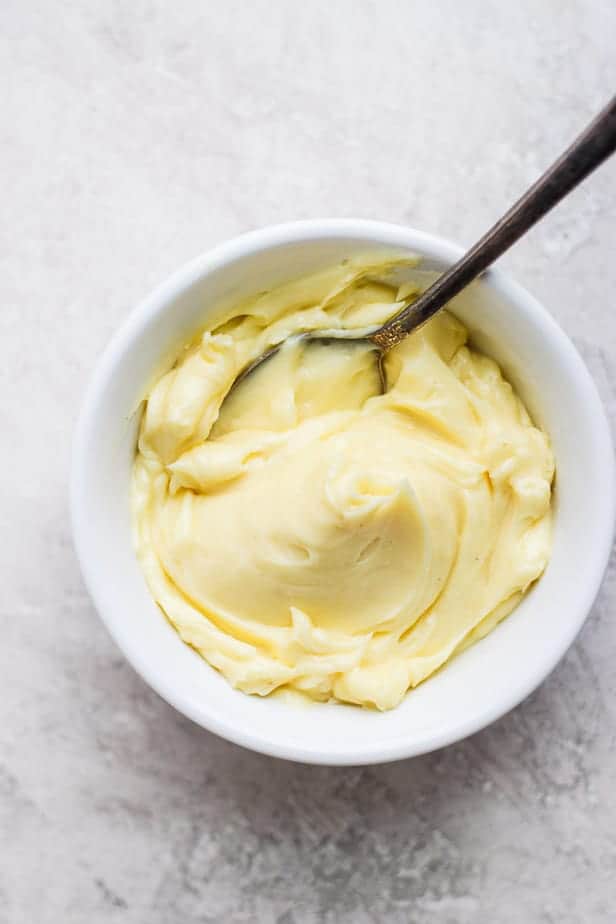
Homemade aioli avoids added sugar or food starch that crop up in store-bought aioli and you control the seasonings. Plus, you probably have the ingredients in your kitchen right now.
What is aioli?
Aioli is garlic-flavored mayonnaise. Originally from Provence, in the south of France, in its strictest form aioli, it is made with egg yolks, olive oil, and garlic. But, modern interpretations use a variety of oils and add in almost any flavoring you can think of from truffle to jalapenos, herbs like chives or spices like saffron and smoked paprika.
At its most basic, mayonnaise is the emulsification of two substances that do not naturally mix together easily: egg yolks and oil. The process of energetically whisking by hand or whirring in the food processor forces droplets of the oil into the liquified egg yolks.
Ingredients to make aioli
- Garlic: Make sure you’re using fresh garlic cloves for the recipe. Two is enough.
- Eggs: You’ll only need the yolks, so save the egg whites for another use.
- Canola oil: You can also use any neutral oil.
- Dijon mustard: This helps with the emulsification process.
- Lemon juice or white vinegar: The acidity helps balance out the flavors.
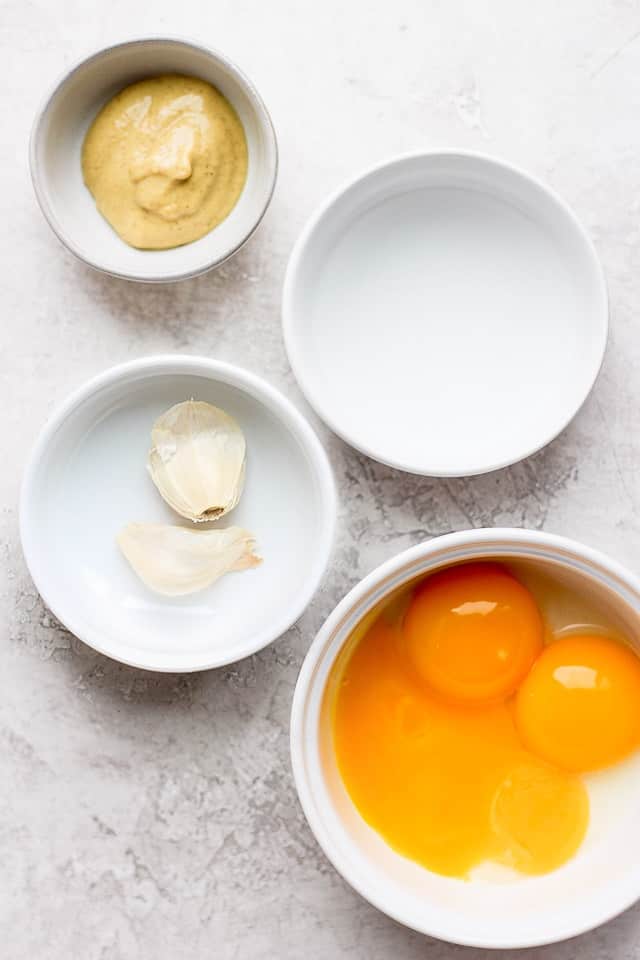
How to make garlic aioli
First, place the egg yolks, garlic, Dijon mustard, salt, and vinegar in the bowl of a food processor.
Next, run the food processor until everything is well-blended, stopping to scrape down the bowl as necessary.
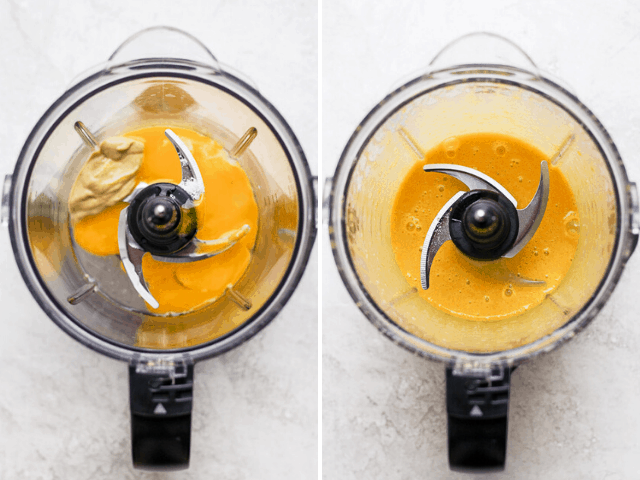
While the food processor is running, slowly stream in the oil until the mix takes on a very creamy texture. Be stingy with the oil to start. Once the mixture is creamy and you have added in at least half of the oil, you can add any remaining oil more quickly.
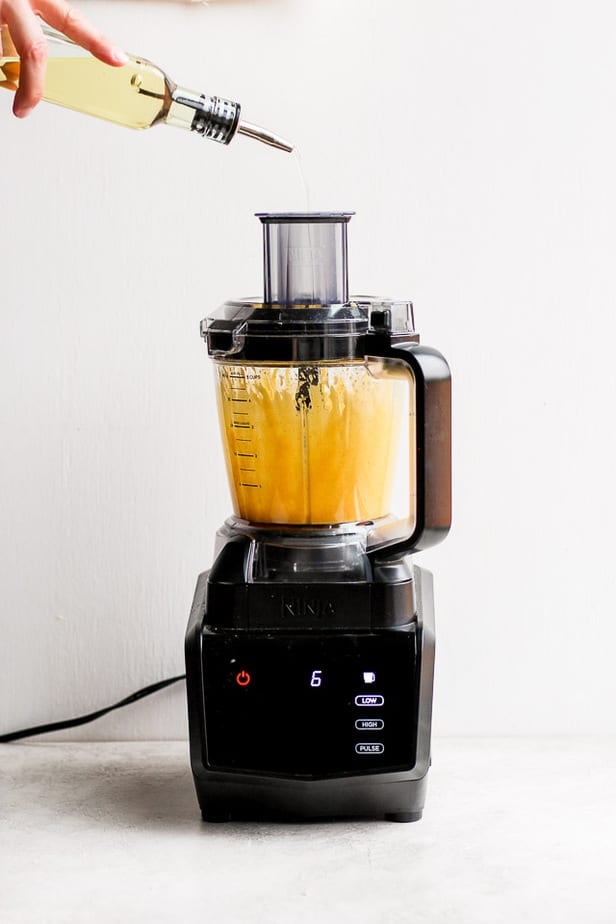
You’re looking for a thick and creamy consistency like mayonnaise. At this point, taste and adjust the seasonings as needed.
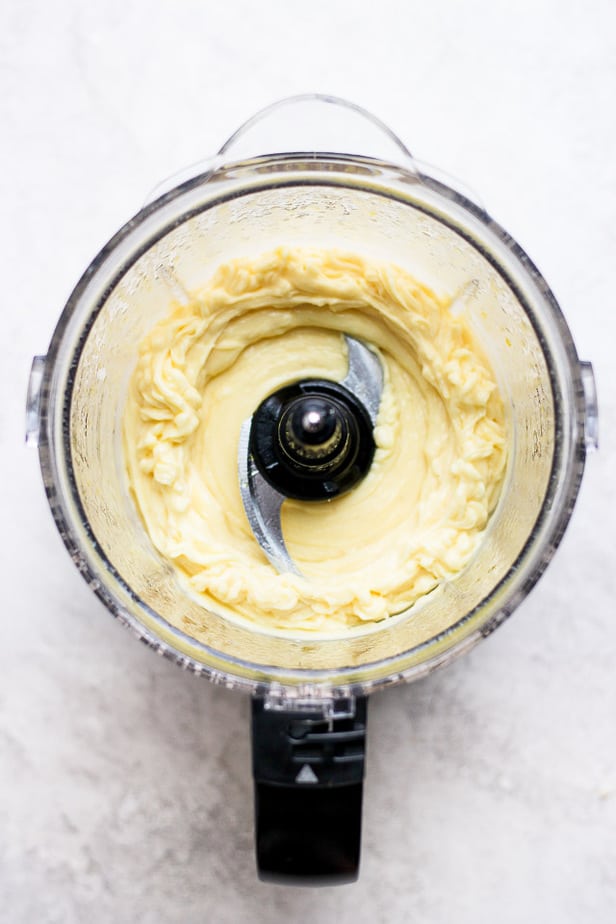
Tips for making homemade aioli
- Use room temperature eggs – the same temp as your oil. It will help the eggs and oil to mix more easily. This is a great tip I learned from Samin Nosrat.
- Taste and adjust for seasoning after mixing. Some flavors, like garlic, will intensify over time.
- This out the aioli by adding water to it after mixing. This is a great tip if you want to thin it out for drizzling over grilled meat or fish or veggies like asparagus.
- Try this tip if you emulsion doesn’t happen (if it breaks). Pour the mixture into a separate container, rinse out your food processor, and start again. This time, use a new egg yolk or a tablespoon of mustard as your new base, start slowly blending the broken mixture (which will act like the oil in this case) into the base until emulsified.
What do you use aoili for?
- Baked Sweet Potato Fries
- Baked Zucchini Fries (Vegan)
- Salmon Burgers
- Quinoa Burger
- Ground Chicken Burgers
- Air Fryer Coconut Shrimp
- Grilled Shrimp Skewers
- Chickpea Fritters
- Broccoli Fritters
- Air Fryer Chicken Wings
- Pizza Quinoa Bites
- Mac and Cheese Bites
- Crudite Platter Wreath
- Broccoli & Cheese Hand Pies
Frequently asked questions
Because of the lack of preservatives in homemade aioli, I do not recommend keeping beyond four days.
No aoili doesn’t freeze well. Freezing breaks down the emulsion. The defrosted aioli will be separated and weird, so it’s best to enjoy within a few days of making.
If you can find pasteurized eggs that is a solution. You can look up instructions for home pasteurization of eggs. Remember, the chance of getting sick from raw egg yolk is small, but if you are pregnant or serving small children or someone with health issues, you may not want to take the risk.
It depends on what I am serving! For fish, I like a little lemon juice or zest added. As a sandwich spread, it is nice to add heat via some chile pepper. Think about which flavors will enhance your meal.
It might take some practice to master aioli, but once you do, it will become part of your rotation. Homemade aioli instantly elevates a simple dinner of grilled meat or fish and turns basic oven fries into something really special.
For more cooking resources:
- How to Cook White Rice
- How to Cook Brown Rice
- How to Cook Quinoa in a Pot
- How to Cook Pasta
- How to Peel Garlic
- How to Cook Chickpeas
- How to Make Oatmeal
If you’ve found this cooking resource for How to Make Aioli helpful or if you’ve tried any recipe on FeelGoodFoodie, then don’t forget to rate the recipe and leave me a comment below! I would love to hear about your experience with this technique. And if you snapped some shots of it, share it with me on Instagram so I can repost on my stories!

order MY book
The Feel Good Foodie Cookbook is now available everywhere books are sold!
Amazon TargetBarnes & Noble Books A Million Hudson Booksellers BookshopSCHULER Books

How to Make Aioli
Ingredients
- 2 garlic cloves
- 3 egg yolks
- 1 tablespoon Dijon mustard
- 1 tablespoon lemon juice or white vinegar
- ½ teaspoon salt
- 1 ½ cups oil canola, safflower, grapeseed
Instructions
- Place the garlic, egg yolks, Dijon mustard, salt, and vinegar in the bowl of a food processor.
- Run the food processor until everything is well blended, stopping to scrape down the bowl as necessary.
- While the food processor is running, slowly stream in the oil until it has been fully incorporated and it starts to look creamy
- Taste and adjust the seasoning as needed.
Notes
Nutrition
Nutrition information provided is an estimate. It will vary based on cooking method and specific ingredients used.





